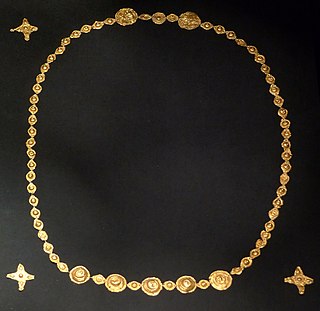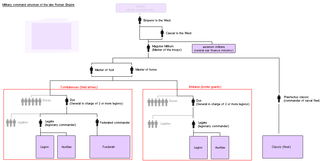Related Research Articles

The Vandals were a Germanic people who first inhabited what is now southern Poland. They established Vandal kingdoms on the Iberian Peninsula, Mediterranean islands, and North Africa in the fifth century.

Julius Nepos, or simply Nepos, ruled as Roman emperor of the West from 24 June 474 to 28 August 475. After losing power in Italy, Nepos retreated to his home province of Dalmatia, from which he continued to claim the western imperial title, with recognition from the Eastern Roman Empire, until he was murdered in 480. Though Nepos' successor in Italy, Romulus Augustulus, is traditionally deemed the last western Roman emperor, Nepos is regarded by some historians as the true last emperor of the west, being the last widely recognised claimant to the position.

Constantius III was briefly Western Roman emperor in 421. He earned his position as Emperor due to his capability as a general under Honorius, achieving the rank of magister militum by 411. That same year, he suppressed the revolt of Constantine III, a Roman general who had declared himself emperor. Constantius then went on to lead campaigns against various barbarian groups in Hispania and Gaul, recovering much of both for the Western Roman Empire. Constantius married Honorius's sister Galla Placidia in 417, a sign of his ascendant status, and was proclaimed co-emperor by Honorius on 8 February 421. He reigned for seven months before dying on 2 September 421.
Foederati were peoples and cities bound by a treaty, known as foedus, with Rome. During the Roman Republic, the term identified the socii, but during the Roman Empire, it was used to describe foreign states, client kingdoms or barbarian tribes to which the empire provided benefits in exchange for military assistance. The term was also used, especially under the empire, for groups of "barbarian" mercenaries of various sizes who were typically allowed to settle within the empire.

Magister militum was a top-level military command used in the later Roman Empire, dating from the reign of Constantine the Great. The term referred to the senior military officer of the empire. In Greek sources, the term is translated either as strategos or as stratelates.

The term Western Roman Empire is used in modern historiography to refer to the western provinces of the Roman Empire, collectively, during any period in which they were administered separately from the eastern provinces by a separate, independent imperial court. Particularly during the period from 395 to 476 AD, there were separate, coequal courts dividing the governance of the empire into the Western provinces and the Eastern provinces with a distinct imperial succession in the separate courts. The terms Western Roman Empire and Eastern Roman Empire were coined in modern times to describe political entities that were de facto independent; contemporary Romans did not consider the Empire to have been split into two empires but viewed it as a single polity governed by two imperial courts for administrative expediency. The Western Empire collapsed in 476, and the Western imperial court in Ravenna disappeared by 554 AD, at the end of Justinian's Gothic War.
Prosopography of the Later Roman Empire is a work of Roman prosopography published in a set of three volumes collectively describing many of the people attested to have lived in the Roman Empire from AD 260, the date of the beginning of Gallienus' sole rule, to 641, the date of the death of Heraclius. Sources cited include histories, literary texts, inscriptions, and miscellaneous written sources. Individuals who are known only from dubious sources, as well as identifiable people whose names have been lost, are included with signs indicating the reliability. A project of the British Academy, the work set out with the goal of doing
"...for the later Empire what the Prosopographia Imperii Romani has done for the Principate, to provide the materials for the study of the governing class of the Empire. The majority of the entries will be persons holding official posts or rank together with their families, and the work will not include clerics except in so far as they come into the above categories."
The logothetes tou stratiotikou, rendered in English as the Logothete of the Military or Military Logothete, was a Byzantine imperial official in charge of the pay and provisioning of the Byzantine army. The office appears in the late 7th century and is mentioned until the 14th century.
Cothelas, also known as Gudila, was a king of the Getae who ruled an area near the Black Sea, between northern Thrace and the Danube. His polity also included the important port of Odessos. Around 341 BC, he concluded a treaty with Macedonian king Philip II, becoming his vassal. This relation was further cemented when Cothelas' daughter, Meda of Odessa, became one of the Macedonian king's wives. The tomb of Cothelas is probably at the Getic burial complex near the present day Bulgarian village of Sveshtari, in North-Eastern Bulgaria.
Heraclius of Edessa was an Eastern Roman Empire general who took part in the failed campaign against the Vandals in 468.

Gaiseric, also known as Geiseric or Genseric was king of the Vandals and Alans from 428 to 477. He ruled over a kingdom and played a key role in the decline of the Western Roman Empire during the 5th century.
Stotzas, also Stutias, Theophanes writes him Tzotzas (Τζότζας), was an East Roman (Byzantine) soldier and leader of a military rebellion in the Praetorian prefecture of Africa in the 530s. Stotzas attempted to establish Africa as a separate state and had been chosen by the rebelling soldiers as their leader. Nearly succeeding in taking Carthage, Stotzas was defeated at the Battle of the River Bagradas by Belisarius and fled into Numidia, where he regrouped. After another attempt at taking control of Africa, Stotzas was defeated by Germanus in 537 and fled with some of his followers into Mauretania.

The Vandal Kingdom or Kingdom of the Vandals and Alans was a confederation of Vandals and Alans, which is one of the barbarian kingdoms established under Gaiseric, a Vandal warrior. It ruled in North Africa and the Mediterranean from 435 to 534 AD.
Masuna or Massonas was a Berber from what is now western Algeria who was said to have been a Christian, he ruled the Mauro-Roman Kingdom with its capital based in Altava which is now in present-day Algeria around the Tlemcen area. He was able to maintain the independence of his kingdom by resisting occupation from the Vandals. King Masuna allied with the Eastern Roman Emperor Justinian and assisted him in a war against the Vandals in 533 and also against other invading Berber tribal confederations. During his reign he was obeyed by the tribes of Mauretania.

The province of Epirus was a province of the Roman Empire, covering the region of Ancient Epirus. Rome first annexed the region in 167 BC, in the aftermath of the Third Macedonian War, and initially put the region in the larger Roman province of Macedonia, which at the time covered the whole of the Hellenistic world in mainland Europe. In 27 BC, Epirus and Achaea were separated from Macedonia and grouped into the senatorial province of Achaea, with the exception of its northernmost part, which remained part of the province of Macedonia. Under Emperor Trajan, sometime between 103 and 114 AD, Epirus became a separate province, under a procurator Augusti. The new province extended from the Gulf of Aulon (Vlorë) and the Acroceraunian Mountains in the north to the lower course of the Acheloos River in the south, and included the northern Ionian Islands of Corfu, Lefkada, Ithaca, Cephallonia, and Zakynthos.

The Mauro-Roman Kingdom was an independent Christian Berber kingdom centred in the capital city of Altava which controlled much of the ancient Roman province of Mauretania Caesariensis. The kingdom was first formed in the fifth century as Roman control over the province weakened and Imperial resources had to be concentrated elsewhere, notably in defending the Roman Italy itself from invading Germanic tribes.

The Kingdom of the Aurès was an independent Christian Berber kingdom primarily located in the Aurès Mountains of present-day north-eastern Algeria. Established in the 480s by King Masties following a series of Berber revolts against the Vandalic Kingdom, which had conquered the Roman province of Africa in 435 AD, Aurès would last as an independent realm until the Muslim conquest of the Maghreb in 703 AD when its last monarch, Queen Dihya, was slain in battle.
John Robert Martindale is a British historian specializing in the later Roman and Byzantine empires. Martindale's major publications are his magnum opus, the Prosopography of the Later Roman Empire, begun by A. H. M. Jones and published between 1971 and 1992, and the first part of Prosopography of the Byzantine Empire, which was published in 2001.
Arcadius, Paschasius, Probus and Eutychius were Chalcedonian Christian martyrs. Natives of Hispania, they became loyal counsellors of the Vandal king Gaiseric, but were ultimately proscribed, exiled, tortured and executed in 437 for refusing the king's command to convert to Arianism. Their story is recounted in the contemporary chronicle of Prosper of Aquitaine. Paschasius and Eutychius, whose name is sometimes given as Eutychian, were brothers.

The Gothic War in Spain was a military operation of the Visigoths commissioned by the West Roman Empire. This operation consisted of multiple campaigns that took place between 416 and 418 and were directed against the Vandals and the Alans to restore Roman power in the Spanish provinces of Betica, Lusitania and Cartaginense. As far as is known, the Roman field army was not involved in the battles, only foederati units fought on the side of the Romans. According to Thompson played the Hasdingi in Gallaecia a dubious role in this war.
References
- ↑ A. D. 395-527, Parts 395-527: Volume 2 of The prosopography of the later Roman Empire , J. R. Martindale (1980)
- ↑ Barbarian tides: the migration age and the later Roman Empire , Walter A. Goffart (2006)